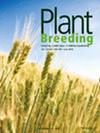Flavour improvement in early generations of fresh market tomatoes (Solanum lycopersicum L.): II. Response to breeders' sensory and marker‐assisted selection
IF 1.8
4区 农林科学
Q2 AGRONOMY
引用次数: 0
Abstract
Fresh market tomatoes are often characterized by poor flavour. Flavour is a quantitative trait difficult to assess and often neglected in breeding. Classical sensory methods are not suitable for the evaluation of early segregating generations; simple physicochemical measurements are not sufficient to predict perceived aroma. Alternative selection methods are needed, such as the recently introduced Breeders' Sensory Test or marker‐assisted selection (MAS). Two unrelated crosses were chosen to evaluate the efficiency of phenotypic selection with the Breeders' Sensory Test (breeders' sensory selection, BS) and MAS for five quantitative trait loci for sweetness, sourness and tomato aroma (mapped in ‘Resi’ × ‘Auriga’) in organic low‐input and hydroponic cultivation. Selection for sensory attributes reduced fruit weight, emphasizing the challenge of breeding flavourful, large‐fruited tomatoes. Both selection methods were more effective in ‘Roterno F早期新鲜上市番茄(Solanum lycopersicum L.)的风味改良:II.对育种者感官和标记辅助选择的响应
新鲜上市的番茄通常风味不佳。风味是一种难以评估的数量性状,在育种中往往被忽视。经典的感官方法不适合评估早期分离世代;简单的理化测量不足以预测感知到的香味。需要采用其他选择方法,如最近引入的育种者感官测试或标记辅助选择(MAS)。我们选择了两个无亲缘关系的杂交品种,以评估在有机低投入栽培和水培条件下,利用育种家感官测试(育种家感官选择,BS)和 MAS 对甜度、酸度和番茄香气的五个数量性状位点('Resi' × 'Auriga')进行表型选择的效率。对感官属性的选择降低了果实重量,突出了培育风味浓郁、果实大的番茄所面临的挑战。这两种选育方法对来自较远亲本的'Roterno F1'×'Black Cherry'更为有效。在早期分离世代中,甜度和番茄香味方面观察到 MAS 效率较高的趋势。然而,BS 的一个主要优势是其普遍适用性。为了改善风味,建议将这两种方法结合起来。
本文章由计算机程序翻译,如有差异,请以英文原文为准。
求助全文
约1分钟内获得全文
求助全文
来源期刊

Plant Breeding
农林科学-农艺学
CiteScore
4.40
自引率
5.00%
发文量
74
审稿时长
3.0 months
期刊介绍:
PLANT BREEDING publishes full-length original manuscripts and review articles on all aspects of plant improvement, breeding methodologies, and genetics to include qualitative and quantitative inheritance and genomics of major crop species. PLANT BREEDING provides readers with cutting-edge information on use of molecular techniques and genomics as they relate to improving gain from selection. Since its subject matter embraces all aspects of crop improvement, its content is sought after by both industry and academia. Fields of interest: Genetics of cultivated plants as well as research in practical plant breeding.
 求助内容:
求助内容: 应助结果提醒方式:
应助结果提醒方式:


